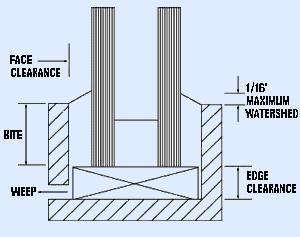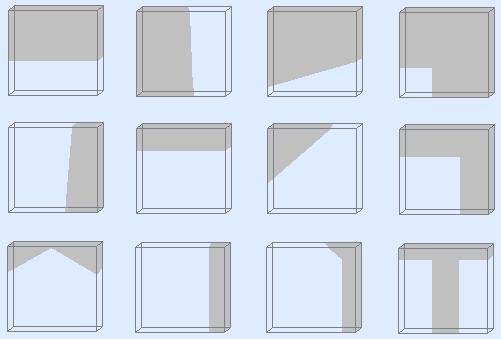MAG offers these glazing instructions to assist our customers in making each insulating glass installation a long lasting one. Our Mid-Lite Insulating Glass is designed and fabricated for durability in a variety of field applications. By following these instructions, glass breakage can be minimized by limiting the impacts of thermal and mechanical stresses, and premature failure of insulating glass products can be avoided. These instructions are derived from the Glass Association of North America (GANA) glazing manual (2004) and accepted industry practices. Any violations of these instructions, whether intentional or unintentional, will automatically void MAG’s warranty.
Glass Handling and Storage
Care must be taken during the handling, transportation, and glazing of insulating glass to insure that edge damage does not occur.
- Do not allow the glass edges to contact the frame or any hard surface during glazing installation.
- Insulating glass is not to be rolled or “cartwheeled” on its corners. A rolling block should always be used when rotating glass to prevent corner damage.
Proper storage and jobsite protection of insulating glass is the responsibility of the glazing contractor.
- Store crated glass in a cool, dry, shady and well-ventilated area where it will not be subject to rain or direct sun.
- If glass must be stored outdoors, cover with waterproof plastic or canvas in such a manner as to allow air circulation around glass. This is required to minimize the potential for condensation which could cause staining of the glass.
- Glass should be stored on a lean of 5 to 7 degrees from vertical using broad, sturdy uprights.
- Weathering metals, welding, sandblasting, or acid washing in the vicinity of the installed IG unit can cause damage to the glass surface. Materials such as paint, concrete, mortar, plaster, drywall spackle or other similar material can stain, etch, or pit glass if allowed to harden on them. Care must be taken to protect the glass from such materials or materials should be immediately flushed from the glass surface with clean water or suitable solvent.
| Glass Clearance and Bite |
Adequate edge and face clearances are essential to allow cushioning of the IG unit within the framing system. Adequate bite relative to an IG unit’s size provides a barrier to air and water infiltration, as well providing pressure to support a unit’s edge under deflection. Inadequate clearances can cause glass breakage as a result of glass to frame contact or even increase the risk of thermal breakage. The following are MAG’s recommended clearance and bite values: |
 |
Recommended Minimum Face & Edge Clearance & Glazing Bite |
Thickness |
Recommended Minimums |
Face |
Edge |
Bite |
Insulating Glass |
inches |
mm |
inches |
mm |
inches |
mm |
inches |
mm |
1/2 |
12 |
1/8 |
3.2 |
1/8 |
3.2 |
1/2 |
12.7 |
5/8 |
15 |
1/8 |
3.2 |
1/8 |
3.2 |
1/2 |
12.7 |
3/4 |
19 |
3/16 |
4.8 |
1/4 |
6.4 |
1/2 |
12.7 |
1 |
25 |
3/16 |
4.8 |
1/4 |
6.4 |
1/2 |
12.7 |
Setting Blocks / Side Blocks
Proper size, hardness, and placement of setting blocks is essential to any quality glazing installation. This assures full bearing of the glass, yet allows water passage to the weep holes. These criteria for setting blocks are to be followed:
- Setting blocks should be made of neoprene, EPDM, silicone, or other compatible elastomeric material, and have a Shore A durometer hardness of 85 +/- 5.
- Two identical setting blocks should be used with each glass installation, the preferred location being equidistant from the centerline of the glass at the quarter points of the sill, but not less than 6” from the corner edge.
- Width of the setting block should be at least 1/8” wider than the glass thickness and 1/16” less than full glazing channel width.
- Length of each block should be sized to provide 0.1” of coverage per square foot of glass area, but be not less than 4”.
- Height of the setting block should be adequate to provide the recommended glass bite and minimum glass edge clearance.
Side blocks, or anti-walk blocks, should be used on all dry glazed systems to limit lateral movement of the glass caused by horizontal expansion/contraction, building sway, and creep deflection. These criteria for side blocks are to be followed:
- Side blocks should be made of neoprene, EPDM, silicone, or other compatible elastomeric material, and have a Shore A durometer hardness per manufacturer's recommendations, usually between 50 and 70.
- One side block is to be used per jamb.
- Side blocks are to be a minimum of 4” long, placed in the vertical channel, and sized to allow a 1/8” clearance between the edge of the glass and block.
Drainage/ Limiting Prolonged Exposure to Water
Perhaps the single most important factor in a successful insulating glass installation is the ability of the system to drain all infiltrated water quickly. Exposure to water or moisture vapor for an extended period of time will cause premature failure of any insulating glass unit. MAG requires either impervious weather seals or an adequate weep system to prevent this from occurring.
- Good glazing practices for drainage provides a minimum of one 5/16” hole located at the center of the horizontal/sill member, and/or one 5/16” diameter hole or equivalent slot near each end.
- Weep holes are expected to be properly maintained over the life of an insulating glass unit to prevent inadequate draining of any accumulated water.
- In applications where wood framing is used, wood must be maintained over the life of the unit’s warranty period so as not to absorb excessive moisture or allow water to infiltrate the unit’s glazing rabbet.
- In framing systems where vertical mullions are utilized to drain infiltrated water to the lowest point before weeping to the exterior, it is important that water not be allowed to accumulate on the top of, run down, or accumulate at the edges of the insulating glass unit.
- These principles also apply to any wrap-around glazing gasket application.
Ultimately, it is the responsibility of the glazing installer to provide for the proper drainage of all infiltrated water into the glazing system.
Framing and Erection Tolerances
To avoid unequal stresses in the glass, frames should be square, in plane, free of any internal obstructions, and structurally adequate. The following guidelines are to be followed, along with accepted industry standards for framing deflection and additional information found in the GANA glazing manual:
- Within any rectangular opening, there should be no more than 1/8” difference in the measured length of the diagonals.
- Maximum variation of mullions from plumb or horizontals from level should not exceed +/- 1/8” in 12 feet or +/- ¼” in any single run.
- Framing systems which are designed to have the glazing legs of the horizontal and vertical members in the same plane should have a maximum out-of-plane offset of 1/32” at the frame corners.
- While vertical deflection of mullions that support glass under windload must satisfy appropriate code requirements, deflection in the direction perpendicular to the plane of the wall should not exceed the length of the span divided by 175 or 3/4”, whichever is greater.
- Horizontal deflection under dead load should not exceed an amount which will reduce the glass bite below 75% of the design dimension nor an amount which would infringe on necessary glazing clearances below. Deflection in this direction should be limited to 1/8” maximum.
- Horizontal expansion of framing members should be allowed to minimize joint movements and reduce glass stresses. Expansion joints should not be further apart than 20 feet or every four lites of glass, whichever is less.
Compatibility, Sealants and Glazing Gaskets
- Compounds containing solvents or plasticized oils may not be compatible with a unit’s edge seal. Care must be taken so that these materials do not come in contact with a unit’s edge or their vapors become trapped within the unit’s glazing rabbet.
- Please consult MAG’s compatibility chart for sealants acceptable for use with Delchem’s D2000 reactive hot melt butyl secondary sealant.
- Structural, pressure, or wrap-around gaskets must remain resilient during the unit’s warranty period.
Prevention of Thermal Stresses
Insulating glass units can prematurely fail or glass breakage may occur from thermally induced stresses on the glass or glass edge. The following conditions should be taken into account when considering the effects of thermal stress:
- Interior Heat Traps – air circulation must be adequate to remove heat build-up from behind the glass.
 |
- Draperies, Venetian blinds, or other interior shading devices must be hung so as to provide:
- minimum 1-1/2” clearance at top and bottom or one side and bottom between shading device and surrounding construction.
- minimum 2” clearance between glass and shading device.
- Heating/cooling outlets must be to room side of any interior shading device.
- Signage or other applications to the interior glass surface may cause unequal heating of the glass surface resulting in thermal breakage or seal failure due to excessive heat build-up within the insulating glass unit.
|
- Exterior Shading – excessive thermal edge stress can be created when shadows cast by overhangs, surrounding structures, trees or shrubbery cause unequal temperature differentials in the glass surface. Please consult the diagram below of typical shading patterns for acceptable, marginal, or harmful shading patterns to determine if tempering or heat-strengthening may be required.
Row 1- Acceptable. >50% of glass is in shade.
Row 2- Marginal. >25% of glass is in shade.
Row 3- Harmful. <25% of glass is in shade, and >25% of perimeter is in shade

In conditions where excessive thermal stresses may occur, tempering or heat-strengthening glass increases glass edge strength and decreases the chances for thermal breakage. |

